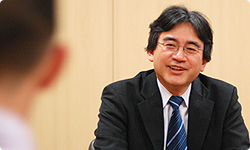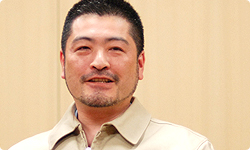3. No Score, No Mistakes
I’d like to ask a little more about breakthroughs on the way to completing Wii Music. When did you decide to rule out wrong sounds no matter how someone plays?
That was soon after I joined.
Why did you decide to do that? Musical instruments are usually something you practice in order to master. Learning to do what you can’t is rewarding as well as enjoyable.
I completely agree.
That’s the basic idea behind traditional music games. What made you decide to exclude mistakes?
That’s exactly what people who can play music say. Their music life revolves around knowing what notes to play and how to play them, note-by-note. They want to know how someone can play all the right notes merely by swinging a remote, which is understandable. But I think both ways are possible. Without a doubt, you can enjoy music by starting from zero and determinedly learn to play step-by-step, but there are other ways to achieve the same results.

I see.
This is a bit of a digression, but when I started working on Wii Music, I hadn’t played many conventional music games, so I tried some out. When I was playing one of them, I was having fun and decided to try to play one of the songs perfectly. I played flawlessly through the last note and, in triumph, laid on an extra note at the end of the song. But when I looked at my score, it wasn’t perfect!
Because of that extra note?
Yeah, it said I’d done something I shouldn’t have. But isn’t adding a note in keeping with the music a good thing? So I wondered if we could make a game that would allow such embellishments and came up with the design we have now, whereby you can play normal melodies or elaborate however you see fit.
Now I understand. What did everyone else think of such a radical concept? Were they hesitant, or did they just accept it?
I’m not sure. At the time I was too absorbed in what I was doing to pay any attention. (laughs) How did you guys react?
I definitely thought it would be fun to play without making any mistakes, but at the time, I was still worried about the nuts and bolts of the game. I was a little worried about how we would bring it all together in the end.
But you could understand how that was another way people could play music?
Yeah, of course.
Well, there’s your answer. (laughs) But at that time, the team wasn’t running smoothly yet. It was quite awhile before we all pulled together to design a game for the purpose of enjoying music for its own sake.
So it took awhile for everyone to get in gear?
Yes.
You must have learned a lot about how hard it is to be a director. (laughs)

Tons. (laughs)
It’s easy to look in from the outside and wonder why a project is floundering (laughs), but once you’re directly involved…
Yeah, it’s a different story. (laughs)
Were there any other important milestones along the way?
I remember something that happened during the latter half of development. Again, it’s about music scores. Even though we thought the freedom that came with turning the score off was fun, that was nothing more than an option. By default setting, it was always turned on.
Oh, so even though playing freely was one good aspect of the game, you still had the default for displaying game-scores set to ‘on’. After all, it is a music game.
Right. That way even someone who didn’t understand music at all would do all right by following the notation. But then everyone would think adhering to the score was the ‘right’ way and never get beyond that.
Yeah, that’s the way it was.
There was a rehearsal mode.
Right. For a while we were going to have a rehearsal mode. You would use that to learn a song by playing along with a score and then play however you wanted - without a score - for the actual performance.
But that was such a long process that we abandoned it.
In the end, it was Miyamoto-san who said we shouldn’t have the default set to ‘on’.

Oh, Miyamoto-san suggested that? He wanted you to be even bolder?
Exactly. (laughs) When was that?
Sometime toward the end.
I think we dropped that mode, say, sometime around the beginning of 2008.
It was toward the end. We showed it to Miyamoto-san and asked what to do about displaying music scores.
Oh, that’s right. Early on we had talked about dropping the music scores. We had him test it and asked if he thought it was more enjoyable without the score. He said it was, so we realized that the best way to do it was without scores.
You knew it was more fun without a score but wondered what the default setting should be for people who don’t know much about music.
Right. Should it be ‘on’ or ‘off’ when you start the game?
That must have been quite a dilemma. Whether there’s something indicating how you should play is extremely important for a music game when you first start. How to set the default was really a philosophical question for us.
I completely agree.
For a long time I thought displaying the scores would be better for beginners so the default was always set to ‘on’.
But then one day Miyamoto-san spoke up.
Yeah. (laughs) He said, ‘Why’s the default still set to “on”?!’
As if to say, you still haven’t made up your mind?!
Yeah. Then we made another giant leap forward.
Right. We’d been relying on music scores so, no matter what we did, it always turned out like a normal music game. Miyamoto-san said we should drop the music scores and concentrate on figuring out the way to tell the players how they can enjoy playing without the scores.
That’s quite a challenging task. You still wanted to allow display of the music score - of course - but the fundamental elements of the game design is to make basic gameplay interesting without it.
Right.
And when you did, it began to feel like the Wii Music we have today?
It sure did.